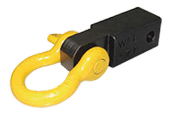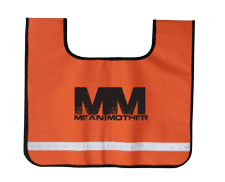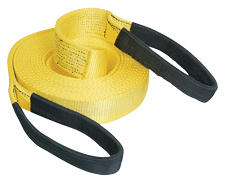Getting bogged can be an inevitable outcome of heading off the beaten track and when this happens, a fully-equipped recovery kit is essential. One item that is indispensable to the process of hauling your rig out of a sticky spot is a snatch strap.
Snatch straps are manufactured from nylon webbing because of its stretchy qualities when compared to polyester, for example. The elasticised nature of a snatch strap means that it
acts like a rubber band — as it stretches, it creates a stored potential energy. This energy is eventually released as kinetic energy, or energy in motion, which is what helps propel a stuck vehicle out of a bog.
- When the snatch strap is not properly attached to a recovery point
- Or if the snatch strap is old or in poor condition
Recovery points:
The recovery points on a vehicle are not documented as manufacturers do not want to be held liable for anything that could break off the chassis during recovery.
.jpg)
Sometimes factory recovery points do not exist at all with some confusing the tie-down point as a recovery point. A tie-down point is used only for transporting a vehicle and therefore is not quite as robust in strength for a recovery. These are usually distinguished by their fairly thin plate and angle towards the ground.
Basically when a snatch strap is attached to a part of a vehicle that is not designed to hold the force and strain of a recovery, something will inevitably give way. Chunks of metal getting torn off your chassis makes for an expensive, inconvenient, and worse, a lethal scenario. This is probably a lesson in investigating the recovery points of your vehicle and deciding if they’re up to the job or not.
In most cases, aftermarket rated recovery points are usually added to 4WDs as one of the more crucial modifications you should do for off-roading.

To these points you can affix a bow shackle to which you attach your snatch strap. Bow shackles allow for more multi-directional movement if you need to recover from an angle when compared to a D-shackle, which only really allows for movement in one, in-line direction. Adding a recovery point to the front and to the rear of your vehicle will have your bases covered in case you’re only able to recover from one end.
Most importantly, never ever slip your snatch strap over your tow ball. Tow balls are not designed for recovery and are destined to snap off under the force of a tense snatch strap. These make them the perfect projectile, which in past cases has ended fatally.
Faulty snatch straps:
Before using your snatch strap, or rather, during the planning phase of your off road trip, always check the condition of your straps. Thoroughly examine the full length of the strap for any nicks or fraying. Do not use the strap if there is any damage, regardless of how minor it may seem.
Make sure your snatch strap is not wet either before use. Nylon webbing readily absorbs water and when wet, the strap becomes weaker and stretches more than it should, increasing the likeliness of it snapping.
Also make sure your snatch strap is not kept in the sun for prolonged periods. Nylon does not have a high resistance to UV radiation, which can break down the material and weaken a snatch strap’s strength and durability.

The only upside of a faulty snatch strap is it is most likely to just snap somewhere in the middle, not necessarily sending any heavy objects flying at you. That said, the lengths of each broken strap will still recoil and, if long enough, could be enough to hit someone and seriously hurt them or worse. Recovery blankets, also referred to as recovery dampers, are a good safety accessory for snatch straps. They are designed to eliminate any whipping action in the case of the strap snapping.
Regardless of whether a recovery blanket is used, all bystanders should stand at least twice the length of the snatch strap away from the vehicles and the strap. Bystanders should also preferably stand parallel to the direction the strap is being pulled and not in front or behind the vehicles.
With these most vital points in mind the following safety steps were compiled and are courtesy of the Queensland Government’s Office of Fair Trading. In the event of having to perform a vehicle recovery with a recovery/snatch strap, these points should absolutely be considered to minimise any chance of serious injury or death.
7 Easy Steps For Recovery (Snatch) Strap Safety:
1. Always follow product instructions. The recommended minimum breaking strength of the strap is twice the gross vehicle mass (GVM) of the lighter of the two vehicles (this should be the bogged vehicle as the towing vehicle should preferably be the same weight or heavier). By law, recovery straps must provide safety warnings and safe use instructions.
2. Always check that the strap is not damaged before use.
3. Make sure that you only attach the recovery strap to a point on the vehicle that is suitably rated for use with the strap or connect it using a Standards compliant shackle with a working load limit greater than the strap’s stated minimum breaking strength. A standard tow ball or vehicle tie-down point is not designed for this purpose. Attaching the strap to these vehicle points or components that could break off can cause injury or death. www.fairtrading.qld.gov.au CS0052 03/11
4. Do not use a recovery strap for lifting or conventional towing.
5. Drape a recovery damper, heavy bag or blanket over the strap during use to reduce any unintended rebounding.
6. While the strap is being used, have bystanders move away from the vehicles to a distance of at least 1.5 times the length of the unstretched strap. Rebounding straps have killed people standing nearby.
7. If you are likely to use recovery straps, obtain certification from a nationally recognised four-wheel-driving training course. For more information on product safety, visit www.fairtrading.qld.gov.au or www.productsafety.gov.au.
Other factors to consider for safe use of a snatch strap:
- Allow your snatch strap a “rest period” so it has time to return to its original condition. The aforementioned energy that is created, also generates heat. Excessive pulling in a short period can cause heat build-up, which may lead to failure.
- Make sure you select a snatch strap that is not too light or too heavy for the recovery. A light snatch strap will most likely snap under the strain, whereas one that is too heavy might not stretch adequately and affect the recovery points.
- Be mindful that your strap does not rub against sharp, abrasive, or hot surfaces.
- Coil your snatch strap when in storage to avoid twisting or kinking the webbing.
Sources:
Mason, S. (n.d.). Recovery points vs tie-down points. Unsealed 4x4. Retrieved from http://unsealed4x4.com.au/issue025/#197
Office of Fair Trading. (2016). 7 easy steps for recovery (snatch) strap safety [PDF flyer]. Retrieved from https://www.productsafety.gov.au/system/files/Recovery%20straps%20safety%20flyer%20%28Queensland%20OFT%29.pdf
Roadsafe 4WD. (2014). Vehicle recovery instructions for safe use and maintenance [digital booklet]. Retrieved from http://roadsafe.com.au/wp-content/uploads/2016/03/Roadsafe-strap-packaging-booklet_final_printfile-june-2014.pdf
Schubert, A. (n.d.). When should you use a snatch strap [Web log post]. Retrieved from http://www.4wdingaustralia.com/4x4/when-should-you-use-a-snatch-strap/
Schubert, A. (n.d.). 20 things you should never do in a 4wd recovery [Web log post]. Retrieved from http://www.4wdingaustralia.com/4x4/20-things-you-should-never-do-in-a-4wd-recovery/



.png)